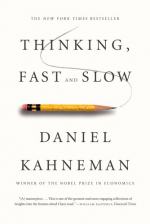
|
| Name: _________________________ | Period: ___________________ |
This test consists of 15 multiple choice questions and 5 short answer questions.
Multiple Choice Questions
1. Who was the director of the CIA when intelligence learned that al-Qaeda may be planning a major attack on the U.S.?
(a) Malcolm Gladwell.
(b) Christopher Chabris.
(c) George Tenet.
(d) Baruch Fischhoff.
2. How is the decision construction of broad framing defined by the author?
(a) A single decision with four options.
(b) Four simple decisions, considered separately.
(c) Two simple decisions, considered separately.
(d) A single decision with two options.
3. In discussing the stock market, the author states that if all the assets in a market are correctly priced, it leaves no scope for cleverness but it also does what?
(a) Creates definitive axioms.
(b) Protects fools from their own folly.
(c) Creates an availability cascade.
(d) Enacts executive control.
4. What creates an asymmetry that makes agreements difficult to reach?
(a) Endowment effect.
(b) Loss aversion.
(c) Narrative fallacy.
(d) Theory-induced blindness.
5. What term refers to the quality of being noticeable or important?
(a) Salience.
(b) Heuristic.
(c) Articulate.
(d) Endowment.
6. Consider the following sentence from Chapter 19 where the author describes people who "knew well before it happened that the 2008 financial crisis was inevitable" (385). What objectionable word does the author point out in this sentence?
(a) Inevitable.
(b) Crisis.
(c) Before.
(d) Knew.
7. Who is the heroine of La Traviata who dies after sacrificing for love?
(a) Maria.
(b) Violetta.
(c) Anna.
(d) Sarah.
8. The author states in the opening of Chapter 29, "Whenever you form a global evaluation of a complex object--a car you may buy, your son-in-law, or an uncertain situation--you" do what (600)?
(a) "Make immediate assumptions."
(b) "Seek advice from experience."
(c) "Evaluate the normalcy of the events or subjects."
(d) "Assign weights to its characteristics."
9. In assessing the stock market, the author asserts that skill in evaluating the business prospects of a firm is not sufficient for stock trading. Traders often lack the skill to answer what crucial question?
(a) Whether the firm is a new firm or an old firm.
(b) Whether the firm has many stockholders or few.
(c) Whether others invested in the stock have faith in its ability to produce.
(d) Whether the information about the firm is already incorporated in the price of its stock.
10. In the following example from Chapter 30, the author posits the following in regards to a person choosing a marble from an urn. The red marbles win a prize. "Urn A contains 10 marbles, of which 1 is red. Urn B contains 100 marbles, of which 8 are red" (631). What are the chances of winning in Urn B?
(a) 10%.
(b) 8%.
(c) 20%.
(d) 16%.
11. What aspect of the mind answers the question: "How was it, on the whole" (734)?
(a) The experiencing self.
(b) The loss-aversive self.
(c) The anchoring self.
(d) The remembering self.
12. Who wrote that "chances of rare events (such as the burst of housing bubbles) receive less impact than they deserve according to their objective probabilities" (639)?
(a) John Gottman.
(b) Craig Fox.
(c) Ralph Hertwig and Ido Erev.
(d) Jim Collins and Jerry I. Porras.
13. What organization paid for Thaler to spend a year working with Kahneman in Vancouver?
(a) The Spencer C. Kaufman Foundation.
(b) The Roosevelt Foundation.
(c) The Michael Conner Foundation.
(d) The Russell Sage Foundation.
14. In utility theory, the utilty of a gain is assessed by comparing what?
(a) The base rates of the subject.
(b) The axioms invested in the states of wealth.
(c) The utilities of two states of wealth.
(d) The heuristics of the subject.
15. Who first demonstrated the hindsight bias as a student in Jerusalem?
(a) Malcolm Gladwell.
(b) Baruch Fischhoff.
(c) John List.
(d) Christopher Chabris and Daniel Simons.
Short Answer Questions
1. The author notes in Chapter 36 that "Caring for people often takes the form of concern for the quality of their stories, not for" what (744)?
2. One of the decision problems that Kahneman and Tversky examined (as discussed in Chapter 25) was whether one would choose a coin toss in which the winner wins $100 or what?
3. The author points out in Chapter 31 that professional golfers putt more successfully when doing what?
4. With what economist did Kahneman and Thaler work closely in Vancouver?
5. Who wrote the 2005 book Expert Political Judgment: How Good Is It? How Can We Know?
|
This section contains 707 words (approx. 3 pages at 300 words per page) |

|




